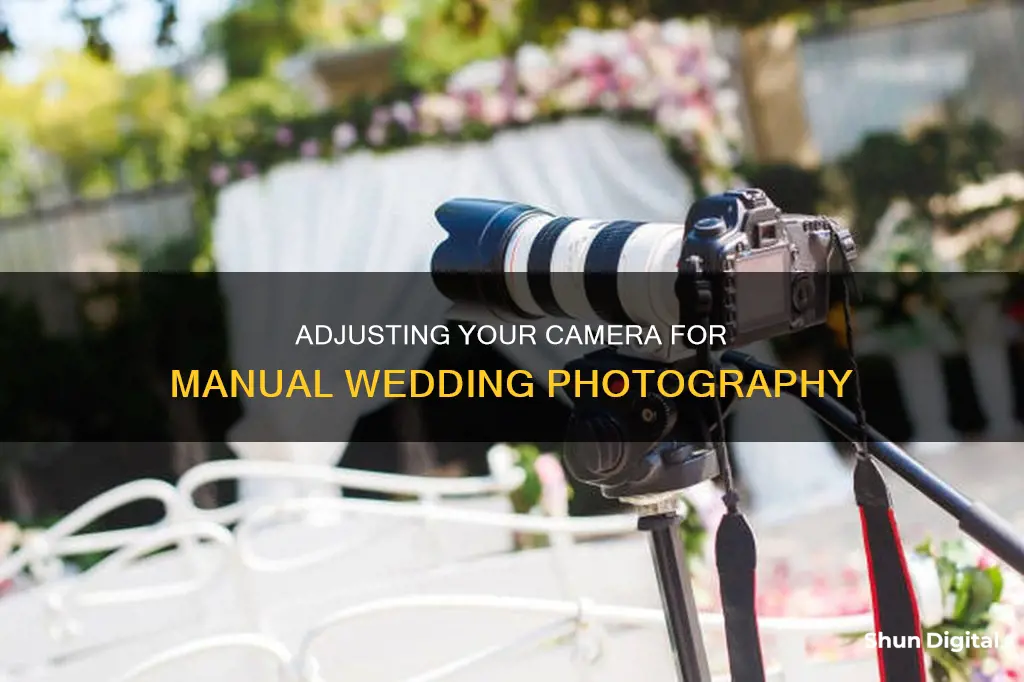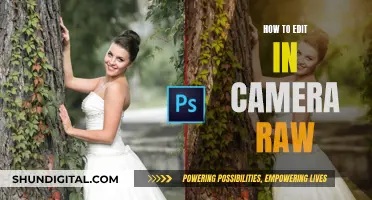
Capturing the perfect shot on a couple's wedding day can be exhilarating and nerve-wracking. Adjusting your camera to manual mode can help you take control of the camera's settings, including aperture, shutter speed, and ISO, and allow you to make precise adjustments based on lighting conditions and your desired creative vision for each shot.
Manual mode gives you complete control over your camera settings. You can adjust the aperture, which controls the light and depth of field; shutter speed, which determines how long the camera's sensor is exposed to light; and ISO, which measures the camera sensor's sensitivity to light.
To shoot in manual mode, first set your aperture based on depth of field considerations. If you want a shallow depth of field, go for a wide aperture, and if you want a sharp background, pick a narrow aperture. Second, set your shutter speed to ensure sharpness. If your subject is stationary, a slower shutter speed will work, but if your subject is moving, you may need a faster shutter speed to avoid motion blur. Finally, set your ISO. If you're shooting in low light, you can boost your ISO to brighten the image, but be mindful that higher ISO settings may introduce noise and graininess to your photos.
While manual mode offers many benefits, it may not be the best option for fast-paced or rapidly changing lighting conditions. In such cases, you may want to use semi-automatic modes like Aperture Priority or Shutter Priority.
| Characteristics | Values |
|---|---|
| Camera mode | Manual Mode |
| Aperture | f/1.8 to f/2.8 for portraits, f/4 to f/5.6 for ceremony shots, f/16 for group photos |
| Shutter speed | 1/60th of a second for posed portraits, 1/500th of a second for reception shots, 1/100th of a second or faster for ceremony shots |
| ISO | 100-400 for portraits, 400-1600 for ceremony shots, 1600-3200 for reception shots |
| Lens | 50mm or 85mm prime lens for portraits, 24-70mm zoom lens for ceremony shots, 24-70mm or 70-200mm zoom lens for reception shots |
What You'll Learn
- Aperture Priority Mode: Set a specific aperture and let the camera choose the shutter speed
- Shutter Priority Mode: Choose the shutter speed and let the camera select the aperture
- Manual Mode: Adjust aperture, shutter speed, and ISO independently
- Exposure Triangle: Control aperture, shutter speed, and ISO for the desired effect
- Lighting and ISO: Adjust ISO for changing light conditions and desired image brightness

Aperture Priority Mode: Set a specific aperture and let the camera choose the shutter speed
Aperture Priority Mode is an excellent alternative to full manual mode, especially in dynamic wedding environments where lighting conditions change frequently.
How to Use Aperture Priority Mode
In Aperture Priority Mode, you can set a specific aperture, and the camera will automatically select the appropriate shutter speed to achieve perfect exposure.
For wedding couple portraits, a wide aperture between f/1.4 and f/2.8 is ideal for achieving a beautiful, blurred background and a sharp subject focus. When photographing the wedding venue and wide shots of the guests, a narrower aperture of around f/4 to f/5.6 will keep more elements in focus.
Benefits of Aperture Priority Mode
Aperture Priority Mode is a preferred choice for many wedding photographers as it allows quick control over the depth of field. It is also useful when you need to change settings rapidly, as you only have to adjust the aperture, and the camera will handle the rest.
Tips for Using Aperture Priority Mode
- ISO settings: Adjust the ISO based on lighting conditions. In good lighting, an ISO of 100 to 200 is sufficient, while in low-light conditions, you may need to increase it to 800 or higher.
- Exposure: Adjust the exposure to brighten or darken your image according to your preference. Avoid overdoing the exposure adjustments, as it can remove details that are challenging to recover in post-processing.
- Aperture (f-stop): A wider aperture (e.g., f/1.8 to f/4) will create a shallow depth of field, blurring the background and emphasizing the subject. A narrower aperture (e.g., f/11 or higher) will result in a sharper image with more elements in focus.
When Not to Use Aperture Priority Mode
While Aperture Priority Mode is versatile, it may not be suitable for capturing quick actions like dancing at a wedding reception, as it requires careful shutter speed management to avoid motion blur. In such cases, switching to manual mode or shutter priority mode may be more appropriate.
Battery Exhausted: Quick Tips to Revive Your Camera
You may want to see also

Shutter Priority Mode: Choose the shutter speed and let the camera select the aperture
Shutter Priority Mode is a semi-automatic mode that allows you to choose the shutter speed and ISO while the camera automatically selects the aperture. This mode is useful when you want to capture moving subjects and need to ensure they remain sharp. It is also useful when working in rapidly changing lighting conditions.
When using Shutter Priority Mode, it is important to consider the movement in your scene when setting the shutter speed. For posed portraits, a slower shutter speed of 1/60th of a second or slightly faster will work well. For dynamic action shots, such as those taken at a wedding reception, a faster shutter speed of around 1/500th of a second will help capture freeze frames.
While Shutter Priority Mode can be useful, it also has its limitations. It does not allow you to control the depth of field in your images, as the camera automatically selects the aperture. Additionally, in low-light conditions, the camera may select a slower shutter speed, which can result in motion blur and camera shake if a tripod is not used.
To effectively use Shutter Priority Mode, it is important to understand the relationship between shutter speed, aperture, and ISO. You can also use Auto ISO to set a minimum shutter speed and prevent blurry images. This mode is particularly useful when shooting handheld or when your subject is moving quickly.
Shutter Priority Mode is a valuable tool for wedding photographers as it allows them to capture sharp images of moving subjects while adapting to changing lighting conditions. By choosing the appropriate shutter speed, ISO, and minimum shutter speed, you can ensure that your images are properly exposed and free from motion blur.
Low Battery, Low Quality: Camera Performance Impact
You may want to see also

Manual Mode: Adjust aperture, shutter speed, and ISO independently
Manual Mode: Adjusting Aperture, Shutter Speed and ISO Independently
Manual mode gives you full control over your camera's settings, allowing you to adjust aperture, shutter speed and ISO independently. This gives you the freedom to be creative and experiment with different effects, but it can be tricky to master.
Aperture
Aperture is the hole in your lens that lets light into the camera. It is measured in f-numbers or f-stops, which are fractions of the focal length of your lens. The lower the f-number, the wider the aperture, and the more light that enters the camera. A wide aperture (e.g. f/2) is great for low-light conditions and for creating a shallow depth of field, which blurs the background and keeps the subject in focus. A narrow aperture (e.g. f/22) lets in less light and gives you a deeper depth of field, so more of the image is in focus.
Shutter Speed
Shutter speed controls how long the shutter stays open, and therefore how long light is allowed to enter the camera. It is measured in fractions of a second, so 1/125 means one-one-hundred-and-twenty-fifth of a second. A slow shutter speed lets in more light and creates motion blur, while a fast shutter speed (e.g. 1/500) freezes movement and gives a crisp, clean image.
ISO
ISO controls your camera's sensitivity to light. A low ISO (e.g. 100) is best for bright conditions, while a high ISO (e.g. 6400) is needed for low-light conditions. However, the higher the ISO, the grainier your image will be.
Putting it all Together
When you shoot in manual mode, you need to adjust these three settings independently to get the correct exposure. For example, if you want to shoot in low light without a flash, you might choose a wide aperture (to let in more light), a slow shutter speed (to increase light exposure) and a high ISO (to increase the camera's sensitivity to light). On the other hand, if you're shooting in bright conditions and want a sharp, focused image, you might opt for a narrow aperture, fast shutter speed and low ISO.
It takes practice to get the hang of manual mode, but it's worth it for the creative control it gives you.
Charging Your Polaroid Z2300: A Quick Guide
You may want to see also

Exposure Triangle: Control aperture, shutter speed, and ISO for the desired effect
The exposure triangle is a term used to describe the three variables that determine how a camera captures light: aperture, shutter speed, and ISO. These three elements work together to properly expose a shot. Adjusting one of these variables will require you to adjust another to maintain the correct exposure.
Aperture
The aperture is the opening in your camera's lens that lets light through to the sensor. A wider aperture will let in more light, while a narrower aperture will let in less light. Aperture is measured in f-stops, with lower f-numbers indicating a wider aperture and higher f-numbers indicating a narrower aperture. A wider aperture will also result in a shallower depth of field, allowing you to blur the background and focus on your subject. Conversely, a narrower aperture will result in a sharper image with a greater depth of field.
Shutter Speed
Shutter speed refers to how long the camera's sensor is exposed to light. A faster shutter speed will result in less light being let in, while a slower shutter speed will let in more light. Shutter speed is measured in seconds or fractions of a second. A faster shutter speed will freeze motion, making it ideal for sports and action photography. A slower shutter speed will create motion blur, which can be used for creative effects such as light trails or a sense of movement in your image.
ISO
ISO refers to the sensitivity of your camera's sensor to light. A lower ISO value will result in less sensitivity to light, while a higher ISO value will make the sensor more sensitive. ISO can be adjusted to compensate for low-light conditions, but it's important to note that higher ISO values can introduce more noise or graininess to your images.
Putting It All Together
To achieve the desired effect in your photos, you need to balance these three elements of the exposure triangle. For example, if you want to freeze motion in a low-light environment, you might use a wider aperture (lower f-number) and a faster shutter speed while increasing the ISO to ensure your image is properly exposed. On the other hand, if you want to create a sense of movement with a blurred background, you could use a slower shutter speed, a wider aperture, and a lower ISO value.
Charging the Crosstour Action Camera: A Quick Guide
You may want to see also

Lighting and ISO: Adjust ISO for changing light conditions and desired image brightness
When it comes to wedding photography, lighting and ISO adjustments are crucial for capturing the perfect shot. ISO, or International Organization for Standardization, is a setting on your camera that controls its sensitivity to light. By changing the ISO, you can make your images brighter or darker, which is essential for adapting to the varying lighting conditions of a wedding.
The Impact of Lighting on ISO
The amount of light in a scene directly affects the ISO setting you should use. In well-lit wedding scenarios, such as outdoor ceremonies or receptions with ample lighting, a lower ISO is preferable. This could range from ISO 100 to 400, depending on the lighting conditions and your camera's capabilities. Using a lower ISO in bright conditions will result in clearer, less noisy images.
On the other hand, when shooting in low-light conditions, such as indoor receptions with dim lighting or evening events, you will need to increase the ISO. Higher ISO values, like 800, 1600, or 3200, become necessary to capture adequately lit photos. While this introduces more noise or grain to your images, it is often a trade-off worth making to ensure your photos are not underexposed or blurry.
Adjusting ISO for Desired Image Brightness
ISO plays a crucial role in controlling the brightness of your images. A lower ISO will result in darker images, as the camera is less sensitive to light. This is ideal for bright conditions, as it helps maintain image quality. Conversely, a higher ISO will make your images brighter, as the camera becomes more sensitive to light. This is beneficial in low-light conditions, allowing you to capture clear photos without slowing down the shutter speed or widening the aperture.
When adjusting your ISO, it's important to strike a balance between image brightness and noise. While higher ISO settings can help you achieve brighter images in low-light conditions, they also introduce more noise. Therefore, it's essential to find the optimal ISO setting that balances brightness and noise for your specific camera and lighting environment.
Tips for Adjusting ISO
- Always try to use the lowest ISO possible to minimize noise and maximize image quality.
- When shooting in low-light conditions, gradually increase the ISO to avoid excessive noise.
- Use your camera's auto ISO feature as a guide to determine the best setting for a particular lighting situation.
- Experiment with different ISO settings in various lighting conditions to understand their impact on your images.
- Balance ISO with other camera settings like aperture and shutter speed to achieve the desired exposure and sharpness.
Fixing the Camera Raw Filter Glitch: A Step-by-Step Guide
You may want to see also
Frequently asked questions
Manual Mode gives you full control over the camera's settings, including aperture, shutter speed, and ISO. This allows you to make precise adjustments based on lighting conditions and your creative vision for each shot. It ensures consistent exposure across all photos, which is crucial for creating a cohesive and visually stunning wedding album.
The best aperture for wedding photography depends on the situation. For portraits, an aperture between f/1.4 and f/2.8 can create a beautiful, blurred background with a sharp subject focus. For group shots or capturing the wedding venue, a narrower aperture (e.g., f/5.6 to f/11) is preferable to keep more elements in focus.
The best ISO for wedding photography is typically a lower ISO (e.g., 100-400) to maximize image quality and dynamic range. However, in low-light conditions, you may need to increase the ISO (e.g., 1600-3200) while being mindful of potential noise in the images.







